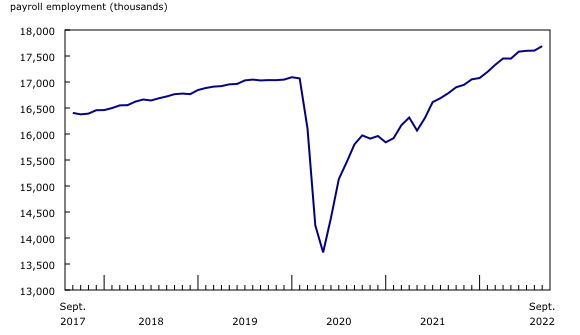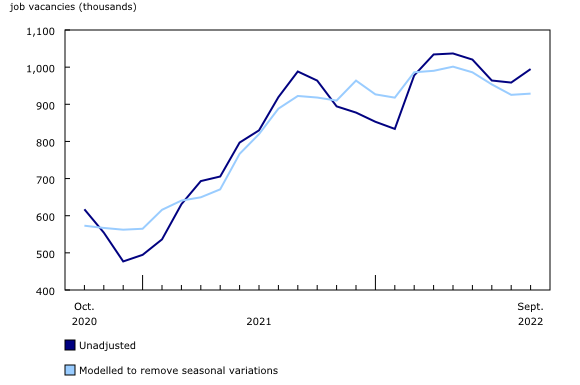The number of employees receiving pay or benefits from their employer—referred to as “payroll employees” in the Survey of Employment, Payrolls and Hours—rose by 85,300 (+0.5%) in September. Gains were largest in Quebec (+39,100; +1.0%), Ontario (+15,300; +0.2%), British Columbia (+10,500; +0.4%) and Alberta (+10,400; +0.5%). Newfoundland and Labrador (-900; -0.4%) was the sole province to see a drop in payroll employment.
Payroll employment increases in both the goods-producing and services-producing sectors
In September, payroll employment increased by 61,400 (+0.4%) in the services-producing sector, accounting for 72% of the overall monthly increase. Overall, 9 of the 15 sectors in the services-producing sector recorded gains, led by health care and social assistance (+20,700; +0.9%), followed by accommodation and food services (+8,400; +0.7%) and retail trade (+8,200; +0.4%). Management of companies and enterprises (-600; -0.5%) was the lone sector to record a decline in payroll employment.
Meanwhile, payroll employment in the goods-producing sector increased by 21,700 (+0.7%). Construction (+18,500; +1.7%) and mining, quarrying and oil and gas extraction (+800; +0.4%) saw increases, while there was little change in forestry and logging, manufacturing, and utilities.
Chart 1
Payroll employment increases in September after little change in August

Payroll employment increases in health care and social assistance
Payroll employment in the health care and social assistance sector increased by 20,700 (+0.9%) in September, following a decline of 1,900 (-0.1%) in August. In total, seven provinces recorded gains in payroll employment, led by Quebec (+11,200; +2.1%), Ontario (+5,300; +0.7%) and Alberta (+1,700; +0.7%). Manitoba (-400; -0.4%) and Newfoundland and Labrador (-100; -0.2%) recorded losses, while British Columbia showed little change.
On a year-over-year basis, payroll employment within the health care and social assistance sector increased by 74,600 (+3.5%) in September. Nationally, child day-care services (+17,600; +11.7%) and general medical and surgical hospitals (+9,800; +1.7%) recorded the largest year-over-year increases within the sector in September.
Payroll employment continues to increase in accommodation and food services in September
Payroll employment in the accommodation and food services sector increased by 8,400 (+0.7%) in September. This brought the total gains since February 2022, following the initial wave of the COVID-19 Omicron variant, to 173,100 (+15.6%). In September, gains were observed in Ontario (+3,500; +0.7%), Quebec (+2,600; +1.0%), Manitoba (+1,200; +2.7%) and Prince Edward Island (+200; +2.7%), while the remaining provinces recorded little change. Despite the monthly gains observed in September, payroll employment in the accommodation and food sector was 4.5% (-60,700) below its pre-pandemic level.
In September, nationally, two-thirds of the industries within the accommodation and food services sector recorded monthly payroll employment growth, led by full-service restaurants and limited-service eating places (+5,100; +0.5%), recreational vehicle parks and recreational camps (+1,900; +10.8%), and traveller accommodation (+1,600; +1.0%).
Payroll employment increases in construction
Payroll employment in construction rose by 18,500 (+1.7%) in September, almost fully offsetting the loss observed in August (-19,500; -1.7%). Overall, eight provinces observed monthly increases, led by Ontario (+6,700; +1.7%), Quebec (+4,800; +2.1%) and British Columbia (+2,700; +1.5%).
Gains were spread across nearly all industries within the sector, led by foundation, structure, and building exterior contractors (+3,900; +3.0%), building equipment contractors (+3,100; +1.0%) and residential building construction (+2,800; +1.7%).
In September, all industries within the sector recorded year-over-year payroll employment increases, with building equipment contractors (+14,400; +5.0%), residential building construction (+13,000; +8.5%) and non-residential building construction (+8,900; +8.1%) leading the gains. In September, all provinces recorded year-over-year payroll employment increases in the sector.
Year-over-year growth in average weekly earnings holds steady in September
Year-over-year growth in average weekly earnings was 3.5% to $1,175 in September, on par with August. In September, four provinces recorded year-over-year growth rates that were larger than the national average, led by New Brunswick (+6.3% to $1,083) and Quebec (+3.7% to $1,118). However, slower growth rates in Prince Edward Island (+2.4% to $986), Alberta (+2.6% to $1,266), British Columbia (+3.2% to $1,176) and Newfoundland and Labrador (+3.3% to $1,159) moderated national earnings growth.
Over the same period, national year-over-year growth in the Consumer Price Index was 6.9% in September. Growth in average weekly earnings can reflect a number of factors, including changes in wages, composition of employment and hours worked.
In September, the year-over-year increase in average weekly earnings in the goods-producing sector (+4.7%) outpaced the overall national average. The largest gains were recorded in forestry and logging (+9.7% to $1,412) and construction (+5.7% to $1,457).
Slower year-over-year growth was observed in the services-producing sector (+3.4%). While the largest gain was recorded in finance and insurance (+15.8% to $1,724), there were losses seen in management of companies and enterprises (-5.9% to $1,494) and educational services (-3.2% to $1,145).
Average weekly hours worked drop year-over-year in September
While there was little monthly change in September, average weekly hours worked were down 0.6% (to 33.3 hours) on a year-over-year basis. Management of companies and enterprises (-7.0% to 34.8 hours) recorded the largest year-over-year decrease, which was mitigated by an increase in forestry and logging (+6.7% to 42.9 hours). Like growth in average weekly earnings, changes in average weekly hours worked can reflect a number of factors, including changes in the composition of employment.
Job vacancies increase in September
Across all sectors, the number of job vacancies was up 3.8% (+36,300) to 994,800 in September. Increases in accommodation and food services (+12.0%; +16,400) and construction (+14.0%; +11,500) were partially offset by declines in manufacturing (-11.3%; -9,700). The total number of job vacancies was little changed on a year-over-year basis.
The month-over-month increase in job vacancies in September was largely attributable to seasonal variations, as job vacancies typically peak in September. When adjusting for seasonal variations, the number of job vacancies levelled off in September, following three consecutive monthly decreases.
Chart 2
Seasonal variations drive job vacancies increase in September

The job vacancy rate, which corresponds to the number of vacant positions as a proportion of total labour demand (the sum of filled and vacant positions), was 5.7% in September, up from 5.4% in August, but down from 5.9% in September 2021.
Seasonal effects drive the increase in job vacancies in accommodation and food services and construction
In accommodation and food services, employers were actively seeking to fill 152,400 vacant positions in September, up 12.0% (+16,400) from the previous month. The increase was predominately due to seasonal variations. On a year-over-year basis, the number of job vacancies was down 19.6% (-37,100) in September. The job vacancy rate in this sector (10.4%) remained the highest among all sectors in September.
Job vacancies also rose 14.0% (+11,500) to 93,900 in construction in September. As in accommodation and food services, the increase largely reflected seasonal effects. Compared with September 2021, job vacancies in construction were up 14.9% (+12,200). The job vacancy rate was 7.4% in September 2022, up from 6.8% in September 2021.
Job vacancies remain high in health care and social assistance
Employers in health care and social assistance were seeking to fill 159,500 vacant positions in September, little changed from the record high reached in August (152,000). Compared with September 2021, job vacancies were up 25.8% (+32,800), the largest year-over-year increase in job vacancies of any sector. The job vacancy rate was 6.6% in the sector, little changed from the record-high rate reached in August (6.4%), but up 1.1 percentage points from September 2021. In the second quarter of 2022, 27.2% of vacancies in the health care and social assistance sector was in hospitals, while 26.8% was in nursing and residential care facilities and 24.5% was in ambulatory health care services. Just over one in five vacancies in the sector (21.5%) were in the social assistance subsector.
Job vacancies little changed in retail trade and professional, scientific and technical services
In September, the number of job vacancies in retail trade (117,300) and professional, scientific and technical services (61,900) was little changed but remained elevated. In September, the job vacancy rate in the retail trade sector was 5.5% and that in the professional, scientific and technical services sector was 5.0%.
Job vacancies decline in manufacturing
The number of job vacancies in the manufacturing sector decreased to 76,000 in September, down 11.3% from August and down 17.6% from its peak of 92,100 in April 2022. This drop occurred following the fourth decline in five months in the sector’s real gross domestic product recorded in August. From August to September, the job vacancy rate declined by 0.5 percentage points to 4.6%.
Increase in job vacancies concentrated in Ontario and Saskatchewan
In September, on a month-over-month basis, job vacancies increased in Ontario (+7.4% to 375,700) and Saskatchewan (+12.2% to 26,700), while they decreased or were little changed in the other provinces.
In September, there was an average of 1.0 unemployed people for each job vacancy in Canada, down from 1.3 in August. This decline reflects both a decrease in unemployment (-289,300) in September (Labour Force Survey, not seasonally adjusted) and an increase in the number of vacancies (+36,300) during the month.
The unemployment-to-job vacancy ratios varied across Canada. In both Quebec and British Columbia, the two provinces with the highest job vacancy rate, the ratio declined to 0.7 in September, after having reached 1.0 in August. Newfoundland and Labrador remained the province with the highest unemployment-to-job vacancy ratio (3.1) in September.













